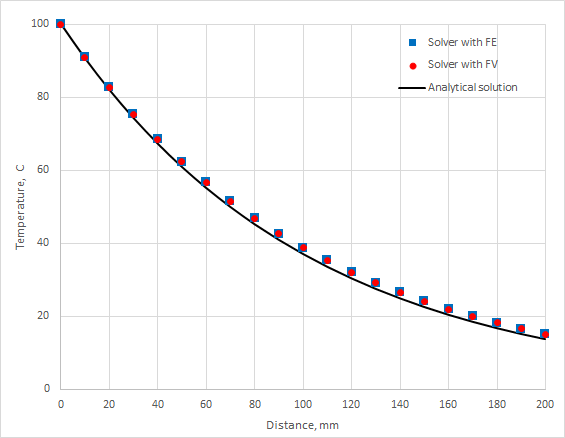VVT18 - Thermal stream on the 2D face
| Solution | Test case |
|---|---|
| Finite volume method | SVTEST23 |
| Finite element method | SVTEST249 |
Description
This validation case examines the thermal stream boundary condition applied to the face of a two-dimensional aluminum plate. The steady-state temperatures predicted by the solver are compared with the analytical solution.
Geometry
The model geometry consists of a two-dimensional plate with dimensions of 100 mm by 200 mm in the y and x directions.
Simulation model
This model uses the Simcenter Multiphysics solver.
2D mesh is generated using plane stress parabolic quadrilateral elements with the size of 10 mm.
The meshed elements have the following material and physical properties:
- Material: Aluminum
- Mass density: ρ= 2660 kg/m3
- Thermal conductivity: k= 117 W/m °C
- Specific heat at constant pressure: Cp = 900 J/kg °C
The fluid is modeled using the air with the following properties:
- Mass density: ρ= 1.2041 kg/m3
- Specific heat at constant pressure: Cp = 1007 J/kg °C
- Dynamic viscosity: µ= 1.85 × 10−5kg/m·s
The following boundary conditions are applied:
- Temperature constraint on the surface of the metal plate with a value of T = 0 °C.
- Thermal Stream on the surface of the metal plate in the x direction with a mass flow rate ṁ = 0.1 kg/s inlet temperature Tf ,i = 100 °C, and a heat transfer coefficient h= 0.01 W/mm2·°C.
The default solver parameters are selected.
Theory
Thermal streams are used to model the thermal effect of finite fluid flow on solid. The steady state fluid temperature equation is given by:
where:
- ṁ is the mass flow rate of the stream, at the current element location.
- Cp is the specific heat of the stream fluid material.
- Tf is the stream fluid temperature.
- b is the height of the plate equal to y.
- h is the heat transfer coefficient between the fluid element and underlying solid element surface.
- Tsolid is the solid element temperature convecting to the stream.
The solution for Tf=Tf,i at x=x0 as follows:
Results
The following figure compares the fluid temperature, which varies with distance, computed by the solver with the finite volume method and finite element method and the temperatures from the analytical solution.

